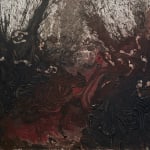


Hermann Nitsch Austria, 1938-2022
19_14, 2014
acrylic on canvas
200 x 300 cm
78 3/4 x 118 1/8 in
78 3/4 x 118 1/8 in
Copyright The Artist
Further images
In his over a 55-year career, Hermann Nitsch has pushed the limits of performance art, staging bloody, ritualistic events across the world. Nitsch is frequently associated with the Viennese Actionists,...
In his over a 55-year career, Hermann Nitsch has pushed the limits of performance art, staging bloody, ritualistic events across the world. Nitsch is frequently associated with the Viennese Actionists, a group of off-kilter Austrian artists who reinvented art in violent terms. Other noteworthy members included Günter Brus, Otto Muehl, and Rudolf Schwarzkogler. Nitsch’s most well-known work is the Orgien Mysterien Theater (1960s–ongoing), which he has performed over 100 times and which has provoked outrage since its inception. These bacchanalian performances include mock religious sacrifices, crucifixion, blood, entrails and nude participants, and produce paintings reminiscent of the revelry that created them. Nitsch is also a painter, creating large canvases pulse with deep reds, blues, and greys, reminiscent of blood spatters. Although Nitsch’s work may appear shocking to onlookers, it is rooted in art history, drawing inspiration from Matthias Grünewald’s Isenheim Altarpiece (1512–1516) and the hanging meats found in some of Rembrandt’s works. Nitsch exhibited work at the 2013 and 2011 Venice Biennale.
Exhibitions
Resistance(s), MARUANI MERCIER, Brussels, June 2021Join our mailing list
* denotes required fields
In order to respond to your enquiry, we will process the personal data you have supplied to communicate with you in accordance with our Privacy Policy. You can unsubscribe or change your preferences at any time by clicking the link in our emails. This site is protected by reCAPTCHA and the Google: Privacy Policy and Terms of Service apply.


